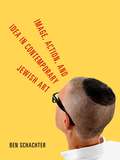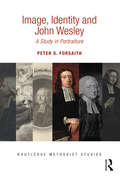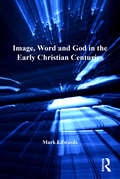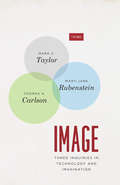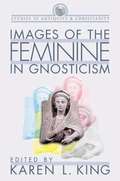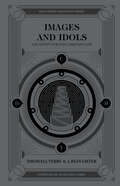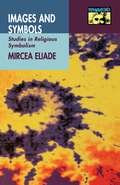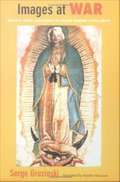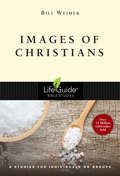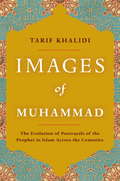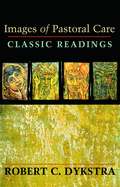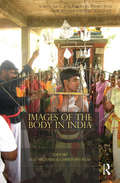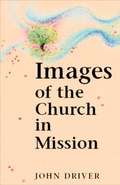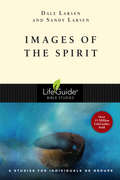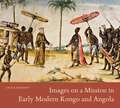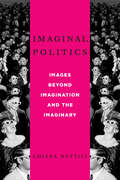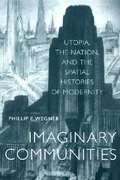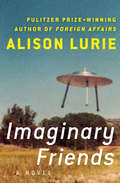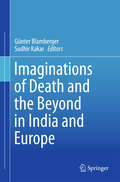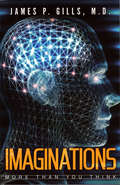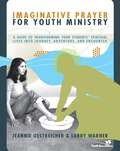- Table View
- List View
Image, Action, and Idea in Contemporary Jewish Art (Dimyonot: Jews and the Cultural Imagination #5)
by Ben SchachterContemporary Jewish art is a growing field that includes traditional as well as new creative practices, yet criticism of it is almost exclusively reliant on the Second Commandment’s prohibition of graven images. Arguing that this disregards the corpus of Jewish thought and a century of criticism and interpretation, Ben Schachter advocates instead a new approach focused on action and process.Departing from the traditional interpretation of the Second Commandment, Schachter addresses abstraction, conceptual art, performance art, and other styles that do not rely on imagery for meaning. He examines Jewish art through the concept of melachot—work-like “creative activities” as defined by the medieval Jewish philosopher Maimonides. Showing the similarity between art and melachot in the active processes of contemporary Jewish artists such as Ruth Weisberg, Allan Wexler, Archie Rand, and Nechama Golan, he explores the relationship between these artists’ methods and Judaism’s demanding attention to procedure.A compellingly written challenge to traditionalism, Image, Action, and Idea in Contemporary Jewish Art makes a well-argued case for artistic production, interpretation, and criticism that revels in the dual foundation of Judaism and art history.
Image, Identity and John Wesley: A Study in Portraiture (Routledge Methodist Studies Series)
by Peter S. ForsaithThe face of John Wesley (1703–91), the Methodist leader, became one of the most familiar images in the English-speaking and transatlantic worlds through the late eighteenth and nineteenth centuries. After the dozen or so painted portraits made during his lifetime came numbers of posthumous portraits and moralising ‘scene paintings’, and hundreds of variations of prints. It was calculated that six million copies were produced of one print alone – an 1827 portrait by John Jackson R.A. as frontispiece for a hymn book. Illustrated by nearly one hundred images, many in colour, with a comprehensive appendix listing known Wesley images, this book offers a much-needed comprehensive and critical survey of one of the most influential religious and public figures of eighteenth-century Britain. Besides chapters on portraits from the life and after, scene paintings and prints, it explores aspects of Wesley’s (and Methodism’s) attitudes to art, and the personality cult which gathered around Wesley as Methodism expanded globally. It will be of interest to art historians as a treatment of an individual sitter and subject, as well as to scholars engaged in Wesley and Methodist studies. It is also significant for the field of material studies, given the spread and use of the image, on artefacts as well as on paper.
Image, Word and God in the Early Christian Centuries (Studies in Philosophy and Theology in Late Antiquity)
by Mark EdwardsChristianity proclaims Christ and the incarnate word of God; the Bible is described as the Word of God in both Jewish and Christian tradition. Are these usages merely homonymous, or would the ancients have recognized a more intimate relation between the word incarnate and the word proclaimed? This book investigates the concept of logos in pagan, Jewish and Christian thought, with a view to elucidating the polyphonic functions which the word acquired when used in theological discourse. Edwards presents a survey of theological applications of the term Logos in Greek, Jewish and Christian thought from Plato to Augustine and Proclus. Special focus is placed on: the relation of words to images in representation of divine realm, the relation between the logos within (reason) and the logos without (speech) both in linguistics and in Christology, the relation between the incarnate Word and the written text, and the place of reason in the interpretation of revelation. Bringing together materials which are rarely synthesized in modern study, this book shows how Greek and biblical thought part company in their appraisal of the capacity of reason to grasp the nature of God, and how in consequence verbal revelation plays a more significant role in biblical teaching. Edwards shows how this entailed the rejection of images in Jewish and Christian thought, and how the manifestation in flesh of Christ as the living word of God compelled the church to reconsider both the relation of word to image and the interplay between the logos within and the written logos in the formulation of Christian doctrine.
Image: Three Inquiries in Technology and Imagination (TRIOS)
by Thomas A. Carlson Mark C. Taylor Mary-Jane RubensteinThe three essays in Image, written by leading philosophers of religion, explore the modern power of the visual at the intersection of the human and the technological. Modern life is steeped in images, image-making, and attempts to control the world through vision. Mastery of images has been advanced by technologies that expand and reshape vision and enable us to create, store, transmit, and display images. The three essays in Image, written by leading philosophers of religion Mark C. Taylor, Mary-Jane Rubenstein, and Thomas A. Carlson, explore the power of the visual at the intersection of the human and the technological. Building on Heidegger’s notion that modern humanity aims to master the world by picturing or representing the real, they investigate the contemporary culture of the image in its philosophical, religious, economic, political, imperial, and military dimensions, challenging the abstraction, anonymity, and dangerous disconnection of contemporary images. Taylor traces a history of capitalism, focusing on its lack of humility, particularly in the face of mortality, and he considers art as a possible way to reconnect us to the earth. Through a genealogy of iconic views from space, Rubenstein exposes the delusions of conquest associated with extraterrestrial travel. Starting with the pressing issues of surveillance capitalism and facial recognition technology, Carlson extends Heidegger’s analysis through a meditation on the telematic elimination of the individual brought about by totalizing technologies. Together, these essays call for a consideration of how we can act responsibly toward the past in a way that preserves the earth for future generations. Attending to the fragility of material things and to our own mortality, they propose new practices of imagination grounded in love and humility.
Images Of The Feminine In Gnosticism (Studies In Antiquity And Christianity)
by Karen L. KingIn this groundbreaking collection of essays, King and other contributors engage in a systematic study of issues of gender in Gnosticism. Using a variety of critical methods, the writers ask questions such as: What is the relationship of gendered images to the real lives of women and men? Did ascetic or libertine practices offer an attractive alternative to women in a patriarchal society? Are the images of strong, female goddesses, saviors, and heroines an indication Gnosticism would have been attractive to women? Is it plausible that women in some gnostic groups were authors, teachers, and leaders? Is it possible that some of the Gnostic texts we possess were written by women? What parts did women play in ritual? Did asceticism or libertinism have a different set of social functions for women than for men? These lucid essays offer significant insights into the cultural context and religious practices of Gnosticism.
Images and Idols: Creativity for the Christian Life
by Thomas J Terry J. Ryan ListerChristians ought to be leading the way in creativity, but we rarely do. God is the Creator of all things, and He created us in His image. Creativity is woven into the very fabric of our humanity. Therefore, Christians should value and champion creativity as a vital part of our image-bearing role. Instead Christians often don&’t know what to do with creatives and creatives don&’t know what to do with Christianity. On one side you have Christians who neglect or discount art, imagination, and beauty altogether. On the other, you have artists who make idols out of each of these good things. Ryan Lister, a theology professor, and Thomas Terry, a spoken word artist and founder of Humble Beast, team up to help restore the connection between creativity and theology. Images & Idols is a theological and artistic exploration of creativity in the Christian life. It will help creatives build a strong theological foundation for their art, while challenging the church to embrace a theology of beauty and creativity.
Images and Idols: Creativity for the Christian Life
by Thomas J Terry J. Ryan ListerChristians ought to be leading the way in creativity, but we rarely do. God is the Creator of all things, and He created us in His image. Creativity is woven into the very fabric of our humanity. Therefore, Christians should value and champion creativity as a vital part of our image-bearing role. Instead Christians often don&’t know what to do with creatives and creatives don&’t know what to do with Christianity. On one side you have Christians who neglect or discount art, imagination, and beauty altogether. On the other, you have artists who make idols out of each of these good things. Ryan Lister, a theology professor, and Thomas Terry, a spoken word artist and founder of Humble Beast, team up to help restore the connection between creativity and theology. Images & Idols is a theological and artistic exploration of creativity in the Christian life. It will help creatives build a strong theological foundation for their art, while challenging the church to embrace a theology of beauty and creativity.
Images and Symbols: Studies in Religious Symbolism
by Mircea EliadeMircea Eliade--one of the most renowned expositors of the psychology of religion, mythology, and magic--shows that myth and symbol constitute a mode of thought that not only came before that of discursive and logical reasoning, but is still an essential function of human consciousness. He describes and analyzes some of the most powerful and ubiquitous symbols that have ruled the mythological thinking of East and West in many times and at many levels of cultural development.
Images and Symbols: Studies in Religious Symbolism (Bollingen Series #684)
by Mircea EliadeMircea Eliade--one of the most renowned expositors of the psychology of religion, mythology, and magic--shows that myth and symbol constitute a mode of thought that not only came before that of discursive and logical reasoning, but is still an essential function of human consciousness. He describes and analyzes some of the most powerful and ubiquitous symbols that have ruled the mythological thinking of East and West in many times and at many levels of cultural development.
Images at War: Mexico from Columbus to Blade Runner (1492-2019)
by Serge Gruzinski"If colonial America was the melting pot of modernity, it was because it was also a fabulous laboratory of images. . . . Just as much as speech and writing, the image can be a vehicle for all sorts of power and resistance. " So writes Serge Gruzinski in the introduction to Images at War, his striking reinterpretation of the Spanish colonization of Mexico. Concentrating on the political meaning of the baroque image and its function within a multicultural society, Gruzinski compares its ubiquity in Mexico to our modern fascination with images and their meaning. Although the baroque image played a decisive role in many arenas, especially that of conquest and New World colonization, its powerful resonance in the sphere of religion is a focal point of Gruzinski's study. In his analysis of how images conveyed meaning across linguistic barriers, he uncovers recurring themes of false images, less-than-perfect replicas, the uprooting of peoples and cultural memories, and the violence of iconoclastic destruction. He shows how various ethnic groups--Indians, blacks, Europeans--left their distinct marks on images of colonialism and religion, coopting them into expressions of identity or instruments of rebellion. As Gruzinski's story unfolds, he tells of Aztec idols, the cult of the Virgin of Guadalupe, conquistadors, Franciscans, and neoclassical attempts to repress the baroque. In the final chapter he discusses the political and religious implications of contemporary imagery--such as that in Mexican soap operas--and speculates about the future of images in Latin America. Originally written in French, this work makes available to an English audience a seminal study of Mexico and the role of the image in the New World.
Images of Anarchy
by Ioannis D. EvrigenisHobbes's concept of the natural condition of mankind became an inescapable point of reference for subsequent political thought, shaping the theories of emulators and critics alike, and has had a profound impact on our understanding of human nature, anarchy, and international relations. Yet, despite Hobbes's insistence on precision, the state of nature is an elusive concept. Has it ever existed and, if so, for whom? Hobbes offered several answers to these questions, which taken together reveal a consistent strategy aimed at providing his readers with a possible, probable, and memorable account of the consequences of disobedience. This book examines the development of this powerful image throughout Hobbes's works, and traces its origins in his sources of inspiration. The resulting trajectory of the state of nature illuminates the ways in which Hobbes employed a rhetoric of science and a science of rhetoric in his relentless pursuit of peace.
Images of Christians: 8 Studies for Individuals or Groups (LifeGuide Bible Studies)
by Bill WeimerScripture offers various metaphors and motifs for God's people: sheep, salt and light, branches, clay jars, friends, disciples, and more.®
Images of Muhammad: Narratives of the Prophet in Islam Across the Centuries
by Tarif KhalidiFrom one of today's leading Muslim scholars, this compelling look at how the Prophet Muhammad has been portrayed throughout the centuries offers a fascinating history of the diversity of Islamic cultures and beliefs.The Prophet Muhammad has been revered for more than fifteen centuries. Today, one in five people throughout the world calls for daily praises and blessings upon him and holds him up as a model of virtue. In IMAGES OF MUHAMMAD, Tarif Khalidi examines the ways Muhammad has been depicted and revered from the immediate aftermath of his death to the present day. With scholarly authority, Khalidi explores how the "biography" of Muhammad has been constructed, reconstructed, and utilized in various Islamic cultures, and traces the influences that have shaped his image, including the profound effect of negative perceptions promulgated by the West. As he describes the great variety of Islamic beliefs and practices, Khalidi illuminates the values and ideas shared by the Sunni, Shia, and Sufi sects, as well as the differences among them, providing Western readers with a clear, objective perspective on the current conflicts within the Muslim world as well as their global repercussions.From the Hardcover edition.
Images of Pastoral Care: Classic Readings
by Robert C. DykstraThis book is an edited volume of works that have predominated over the past several decades in contemporary pastoral theology. Through the writings of nineteen leading voices in the history of pastoral care, Dykstra shows how each contributor developed a metaphor for understanding pastoral care. Such metaphors include the solicitous shepherd, the wounded healer, the intimate stranger, the midwife, and other tangible images. Through these works, the reader gains a sense of the varied identities of pastoral care professionals, their struggles for recognition in this often controversial field, and insight into the history of the disciple.
Images of the Body in India: South Asian and European Perspectives on Rituals and Performativity
by Christoph Wulf Axel MichaelsThis intriguing book engages with the concept of the body in its cultural context by acknowledging and demonstrating that the human body is understood differently in Western and Indian cultures. The contributors go on to show that any attempt to put forward a single concept of the body within Indian culture would be misleading. Divided into three parts, the book examines the considerable and often conflicting variations in body images and body concepts. In Part One the contributors focus on the representation of the body in religious and philosophical texts; representations that emerged from reading, translating and interpreting classical writings from diverse historical and anthropological approaches. Through predominantly ethnographic studies, Part Two explores the role of the body in narratives and ritual performance, from dance to ritualistic ceremonies. Visualisation processes of the body are examined in Part Three, focusing on developments in modern and contemporary periods: from visual practices at the Mughal court, to the multiple bodies of the bride, and the influence of new media. This volume is a fascinating collection of articles for those in the fields of sociology and anthropology, history, religion, cultural studies and South Asian studies.
Images of the Church in Mission
by John DriverJohn Driver offers studies of 12 biblical images for understanding the church. They steer the reader toward a church more in harmony with God's missionary purpose for His people, and toward a mission solidly based in the biblical vision of peoplehood. Driver explores the images of pilgrimage, of God's new order, and of transformation.
Images of the Spirit (LifeGuide Bible Studies)
by Sandy Larsen Dale LarsenHow do you picture the Holy Spirit? Our imagination is likely to run to something like a vague fuzzy cloud. Or perhaps we think of an invisible, impersonal force. No wonder the Holy Spirit is often called "it." While Christians affirm that the Spirit is the third person of the Trinity, we struggle to think of him as a person at all. The Bible is clear that the Holy Spirit is a person. But how can human beings understand who he is? Scripture helps us by giving us strong word pictures of the Spirit as wind, fire, a counselor, anointing oil and more. As you go through these eight-session LifeGuide Bible Study by Dale and Sandy Larsen, you will find that your mental picture of the Spirit comes into focus. And even better, you will find that you can have a real relationship with the third person of the Trinity as you experience the power, comfort and gifts that flow out from the Spirit. For over three decades LifeGuide Bible Studies have provided solid biblical content and raised thought-provoking questions—making for a one-of-a-kind Bible study experience for individuals and groups. This series has more than 130 titles on Old and New Testament books, character studies, and topical studies. PDF download with a single-user license; available from InterVarsity Press and other resellers.
Images on a Mission in Early Modern Kongo and Angola
by Cécile FromontEarly modern central Africa comes to life in an extraordinary atlas of vivid watercolors and drawings that Italian Capuchin Franciscans, veterans of Kongo and Angola missions, composed between 1650 and 1750 for the training of future missionaries. These "practical guides" present the intricacies of the natural, social, and religious environment of seventeenth- and eighteenth-century west-central Africa and outline the primarily visual catechization methods the friars devised for the region. Images on a Mission in Early Modern Kongo and Angola brings this overlooked visual corpus to public and scholarly attention.This beautifully illustrated book includes full-color reproductions of all the images in the atlas, in conjunction with rarely seen related material gathered from collections and archives around the world. Taking a bold new approach to the study of early modern global interactions, art historian Cécile Fromont demonstrates how visual creations such as the Capuchin vignettes, though European in form and crafstmanship, emerged not from a single perspective but rather from cross-cultural interaction. Fromont models a fresh way to think about images created across cultures, highlighting the formative role that cultural encounter itself played in their conception, execution, and modes of operation.Centering Africa and Africans, and with ramifications on four continents, Fromont’s decolonial history profoundly transforms our understanding of the early modern world. It will be of substantial interest to specialists in early modern studies, art history, and religion.
Images on a Mission in Early Modern Kongo and Angola
by Cécile FromontEarly modern central Africa comes to life in an extraordinary atlas of vivid watercolors and drawings that Italian Capuchin Franciscans, veterans of Kongo and Angola missions, composed between 1650 and 1750 for the training of future missionaries. These “practical guides” present the intricacies of the natural, social, and religious environment of seventeenth- and eighteenth-century west-central Africa and outline the primarily visual catechization methods the friars devised for the region. Images on a Mission in Early Modern Kongo and Angola brings this overlooked visual corpus to public and scholarly attention.This beautifully illustrated book includes full-color reproductions of all the images in the atlas, in conjunction with rarely seen related material gathered from collections and archives around the world. Taking a bold new approach to the study of early modern global interactions, art historian Cécile Fromont demonstrates how visual creations such as the Capuchin vignettes, though European in form and crafstmanship, emerged not from a single perspective but rather from cross-cultural interaction. Fromont models a fresh way to think about images created across cultures, highlighting the formative role that cultural encounter itself played in their conception, execution, and modes of operation.Centering Africa and Africans, and with ramifications on four continents, Fromont’s decolonial history profoundly transforms our understanding of the early modern world. It will be of substantial interest to specialists in early modern studies, art history, and religion.
Imaginal Politics: Images Beyond Imagination and the Imaginary (New Directions in Critical Theory #68)
by Chiara BotticiBetween the radical, creative capacity of our imagination and the social imaginary we are immersed in is an intermediate space philosophers have termed the imaginal, populated by images or (re)presentations that are presences in themselves. Offering a new, systematic understanding of the imaginal and its nexus with the political, Chiara Bottici brings fresh perspective to the formation of political and power relationships and the paradox of a world rich in imagery yet seemingly devoid of imagination. Bottici begins by defining the difference between the imaginal and the imaginary, locating the imaginal's root meaning in the image and its ability to both characterize a public and establish a set of activities within that public. She identifies the imaginal's critical role in powering representative democracies and its amplification through globalization. She then addresses the troublesome increase in images now mediating politics and the transformation of politics into empty spectacle. The spectacularization of politics has led to its virtualization, Bottici observes, transforming images into processes with an uncertain relationship to reality, and, while new media has democratized the image in a global society of the spectacle, the cloned image no longer mediates politics but does the act for us. Bottici concludes with politics' current search for legitimacy through an invented ideal of tradition, a turn to religion, and the incorporation of human rights language.
Imaginary Communities: Utopia, the Nation, and the Spatial Histories of Modernity
by Phillip E. WegnerImaginary Communities explores the genre of utopian literature as a tool for understanding the literary, cultural and social theories of modern spatiality.
Imaginary Friends: A Novel
by Alison LurieTwo sociologists infiltrate a cult that pulls them into madness in this &“barbed and richly entertaining&” novel from a Pulitzer Prize–winning author (The Wall Street Journal). Once the nation&’s most popular sociologist, Tom McMann searches for a research subject that will invigorate his career. Unlike any study he&’s seen before, he targets the Truth Seekers, an up-and-coming cult that seeks flying saucers, utopian planets, and new spiritual plains. An irresistible mixture of New Age cranks and sci-fi nerds, they are ruled over by Verena, a beautiful young telepath who believes she has a hotline to another world. The Seekers are isolated, committed, and eccentric, but most importantly, they&’re hiring. Assisted by his wide-eyed young colleague, Roger Zimmern, McMann infiltrates the Truth Seekers, hoping to see how the zealots respond if questioned by someone within their midst. But when Verena&’s babblings start to make a little too much sense, the researchers must choose between losing their minds and buying one-way tickets to outer space. From the National Book Award–shortlisted author of Foreign Affairs, The War Between the Tates, and The Last Resort, this is a richly funny novel that will dazzle and entertain. This ebook features an illustrated biography of Alison Lurie including rare images from the author&’s collection.
Imaginations of Death and the Beyond in India and Europe
by Sudhir Kakar Günter BlambergerThis volume explores current images of afterlife/afterdeath and the presence of the dead in the imaginations of the living in Indian and European traditions. Specifically, it focuses on the deepest and most fundamental uncertainty of human existence---the awareness of human mortality, on which depends any assignment of meaning to earthly existence as also to notions of worldly and otherworldly salvation. This central idea is addressed in the literature, arts, audiovisual media and other cultural artefacts of the two traditions. The chapters are based on two main assumptions: First, that one cannot report on the direct experience of death; so it is only possible to speak allegorically of it. Second, in contemporary Western societies, marked by structural atheism, people look at literature, the arts and mass media to study their depiction and reading of traditionally religious questions of disease, death and the Beyond. This is in contrast to Asian civilizations whose preoccupation with death and Beyond is persistent and perhaps central to the civilizations’ highest thought. The chapters cover a wide spectrum of disciplinary approaches, from psychoanalysis to religious, anthropological, literary and film studies, from sociology and philosophy to art history, and address issues of unsettling power: comforting illusions of afterlife; the relations between afterlife and fertility; visions of technological immortalization of mankind; the problem of thinking about death after the “death of God”; socialist utopias of bodily immortality; fear of Hell and punishment; different concepts in relating the living and the dead; near-death experiences; and cultural practices of spiritualism, occultism and suicide.
Imaginations: More Than You Think
by Dr. James P. GillsWhen a relinquished life becomes faithful to the promises of God, the result is His joy, His peace, and His charity. Dr. James Gills recounts his own period of rest and complacency-brought on by a time of incapacitation. He learned that when we give ourselves over to the thought patterns of the world, we turn our backs on the Lord and His glory.Imaginations: More Than You Think was written so that the reader might understand how rich life can be when we focus our thoughts on God. You will come to treasure its wisdom as you learn to appreciate its four foundational principles:•We are what we think-therefore, our thoughts determine our actions.•Our present thoughts affect how we will spend eternity.•God is most glorified in us when we are most satisfied in Him.•Our greatest joy comes from surrendering our thoughts to God.Dr. Gills teaches the reader how to wake up with love, happiness, and enthusiasm for the new day. True surrender to the satisfaction of being with Jesus and accepting His provision for us sets the reader free from all daily worry and concern.About the author:James P. Gills, M.D. has earned a reputation as the most experienced cataract surgeon in the world. He is the founder and medical director of the renowned St. Luke's Cataract & Laser Institute in Tarpon Springs, Florida. Dr. Gills has dedictaed his life to restoring much more than physical version. His not-for-profit publishing outreach, Love Press, has ditributed well over three million copies of his books on a donation basis through LoveLines: The Honor Innovation.
Imaginative Prayer for Youth Ministry: A Guide to Transforming Your Students' Spiritual Lives into Journey, Adventure, and Encounter
by Jeannie Oestreicher Larry WarnerHow often have you struggled to help your students really grasp God’s love? How often have you been frustrated by their Sunday school answers when you try to draw them into the depths of God’s story? You’re not alone. Many students (and even youth workers brave enough to admit it) are experiencing emptiness, lack of passion, and a growing inability to hear from God. But there is hope. Just use your imagination… God created our imaginations. Why not harness them to encounter our creative God in brand new ways? Try it right now: Picture yourself in a boat with Jesus as the seas grow rough, as the water crashes over the bow. Notice what’s going on…notice your emotions at this critical moment. What is your sense of Jesus’ presence in the midst of the storm? The latter is just one example of the many guided exercises within the pages of Imaginative Prayer for Youth Ministry. You’ll find tools that can help you use imaginative prayer as a means of experiencing the God who is continually reaching out to us. Invite your students to open their imaginations (and their five senses) to God’s spirit and allow God to move and speak directly to them through the 50 imaginative prayer exercises inside. They come complete with instructions, environment suggestions, and optional debrief questions—there’s even a topical/Scripture reference index so you can find just the right exercises to suit your needs. If you want to introduce your students to the God who loves them (in a way that allows them to truly experience that love), imaginative prayer is an effective means to do so—you and your students will never be the same.
